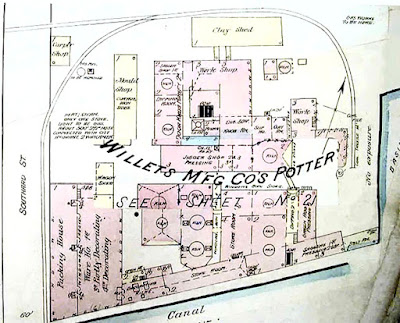I’m a voracious viewer of Turner Classic Movies. As such I’m always watching old movies. One of the fun things about watching old movies as a collector is keeping an eye open for the set decoration on the movies looking for Victorian Majolica. Some movies are naturals for antique decor because they are period pieces. Examples would be movies such as The Age of Innocence and Meet Me in St. Louis. What I don’t expect to find however, is antique pottery in contemporary settings. Imagine my surprise at finding majolica in a classic horror film that I’ve probably seen a hundred times since childhood. This was the case with The Fly.
For those unfamiliar with “The Fly,” it is the story of a scientist whose experiments with transporting matter go terribly wrong. In the process of transporting himself from one place to another his atoms become mixed with those of a housefly giving him the head and leg of a fly while the fly gets his human head and arm. The movie was filmed in the 1950s and is set contemporaneously.
The movie has a surprisingly good cast. The scientist is played by David Hedison, here credited as Al Hedison, who would find fame on tv years later in the science fiction tv series, “Voyage to the Bottom of the Sea.” His brother is played by that stalwart horror movie actor Vincent Price. The police inspector called in to investigate the matter is the great character from the 30s and 40s, actor Herbert Marshall, who will forever be fixed in my mind for two Bette Davis pictures—as Regina Giddens’ ailing husband in The Little Foxes and the cuckold husband in The Letter. (Here’s an interesting bit of useless trivia: Herbert Marshall had a long successful career in Hollywood in spite of having a wooden leg, a fact that was never divulged during his heyday as a leading man.)
The last thing I expected to see in The Fly were two majolica plates as part of the affluent home decor of the scientist and his wife. The plates decorate the family kitchen. I had to do a double take when I saw them. Frankly their presence made me laugh. Can you imagine the reaction of the manufacturer if he knew his work would be immortalized in such a bizarre setting 80 years later?
This design is attributed to Adams’s & Bromley and there are a broad number of matching pieces that can be found to coordinate today. The level of craftsmanship on this series is high.
Spoiler ahead: As is standard in these types of movies, the creature and all of the scientific findings that led to is creation must be destroyed for the good of mankind. The scientist destroys all his notes after which his wife crushes his fly head and arm in a press so no one will ever know this terrible secret. The final scene of the film where the half human half fly is being eaten by a spider provoked nightmares for endless generations of children, myself among them.
In spite of all this death and destruction of course there is a happy ending. With the monster destroyed, the wife accused of murder is absolved of all charges and the whole group walk into the sunset together, no doubt headed to the nearest antique market to enlarge the family collection of majolica.
To view The Fly trailer go here.





































































